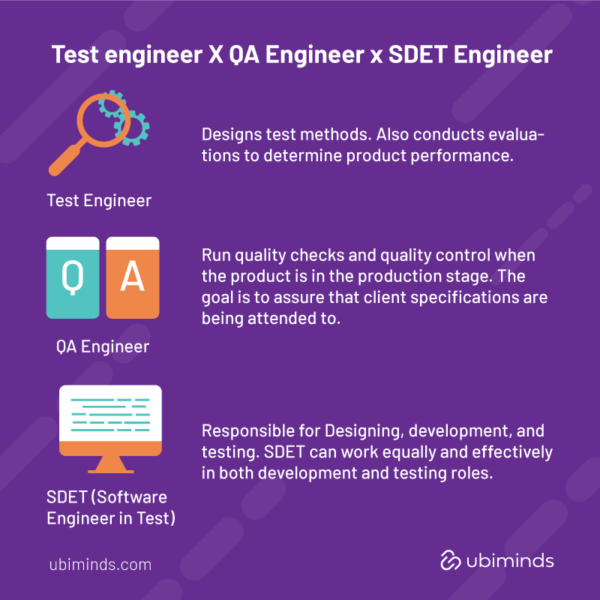Software testing, test engineer, QA engineer, SDET engineer. If you’re a developer and work with technology you couldn’t imagine so many options to choose from in your career, don’t you? The career in information technology is powerful and infinite in possibilities worldwide. Above all, before you start venturing out you should understand the meaning, impact, and responsibilities of each role. Let’s begin?
What is software testing and how does testing ensure products succeed?
Imagine an ideal world where all products built by technology teams were perfect and flawless. It’s clear that this world never existed and never will exist.
But the good news is that software testers are here to support IT teams to improve their products.
How? Pointing out critical errors to correct them. Therefore it’ll be possible to increase systems quality and performance.
What does Software Testing Mean
So, software testing is a method (manual or automated) of checking. Check whether a software matches expected requirements. As a result of Software Testing work, software products will be defect-free.
Responsibilities
Test Engineers, QA Engineers or SDET Engineers are responsible for executing software/system components. They do that by using manual or automated tools to evaluate one or more properties of interest.
The purpose of software testing is to identify errors, gaps, or missing requirements in contrast to actual requirements.
What does Software Testing Impact?
Because Software Testing ensures software quality, it saves an organization time and money. This happens because it reduces software development and maintenance costs. In turn, more time and fewer errors mean:
- Engineers and developers have more room for developers
- Engineers are free to create new features or improve software
Test Engineer, QA Engineer, or SDET Engineer: what is the difference?

When we talk about software testing there are some similarities between:
- Test Engineer
- QA Engineer
- SDET Engineer
Let’s see the difference among them:
| Role | Test Engineer | QA Engineer | SDET (Software Development Engineer in Test) |
| What it does | Designs test methods. Also conducts evaluations to determine product performance. | Run quality checks and quality control when the product is in the production stage. The goal is to assure that client specifications are being attended to. | Responsible for Designing, development, and testing. SDET can work equally and effectively in both development and testing roles. |
How do I become a Software Tester?
To become a Software Tester you need to gather analytical, communication, organization, and time management skills.
In addition, Software Testers should know:
- How to manage their workflow efficiently
- Be productive
- Be oriented to detail a
- Maintain a passion for testing
If you want to work with Software Testing it’s highly recommended to learn the particulars of software.
Performance testing will be a plus for knowledge, as well as programming, computer science, math, or engineering skills.
What does a Quality Assurance Engineer do and what does it take to advance in the QA career?
Quality Assurance Engineers are responsible for assessing the quality of specifications and technical design documents. QA is responsible for ensuring timely, relevant, and meaningful product feedback.
So, to grow your career it’s mandatory to define a focus and continually improve your testing skills. Finally, you can choose to follow a technical path or a test management path.
How do I specialize as a Software Development Engineer in Test and what does it take to advance in this career?
To develop your Testing Career is good to understand how to create, implement and maintain software programs. In addition, it’s good to be able to develop an alternate solution for detected errors. So having strong communication skills in order to serve as part of a technology team will be considered.
How do software engineering teams choose between manual and automated tests?
QA analyst (Human) is responsible for Manual Testing, whereas Automation Testing uses script, code, and automation tools (computer) to test the software.
How to choose between Manual Testing and Automation Testing
| Manual Testing | Automation Testing | |
| What is | It is executed by a human tester and software | It uses automation tools to execute test cases |
| Why choose | To save money in the initial investment | To save time |
What are the different types of Software Testing I can work with?
There are a lot of types for engineers and testers to evaluate the quality of software. Following you find a list of more common types of Software Testing:
Functional Software Testing
- Unit testing. It’s the method of testing software individual units or components to validate their performance.
- Integration testing. It tests individual units/components combined as a group. This allows observing how they interact and work together.
- Smoke/Sanity testing. Smoke testing is to assure that the acute functionalities of a program are working fine. Sanity testing checks the bugs have been fixed after the build.
- User Acceptance testing. It refers to the process where a software product is handed over to the client users. They use the application for a specific time period and approves or rejects the software product.
- Localization testing. It’s performed to verify the quality of a product for a specific culture or local. This ensures that the application is capable enough to be used in that specific region.
- Interoperability testing. It‘s performed to examine software’s interaction either with its components or other software. Interoperability testing checks the functionality relationship between two software systems as per the requirement of end-users.
Non-functional Software Testing
- Performance testing. It’s a method used for testing several things such as speed, response time, and stability. This testing focuses on identifying and eliminating performance bottlenecks.
- Endurance testing. It’s used to check system performance under specific load conditions over an extended or longer amount of time. It falls under types of Performance testing and also is known as Soak testing.
- Load testing. It simulates multiple users accessing the program concurrently. As such, this testing is most relevant for multi-user systems, such as web servers.
- Volume testing. It’s commonly used when you want to test a huge volume of data and to analyze the system performance by increasing the volume of data in the database.
- Scalability testing. It’s used to measure its capability to scale up or scale out in terms of any of its non-functional capability. Performance, scalability, and reliability testing are usually grouped together by software quality analysts.
- Usability testing. The tester invites representative users to identify any usability problems. Also, the tester collects qualitative and quantitative data to determine the participant’s satisfaction with the product.
Maintenance Testing
- Regression testing: testers re-run functional and non-functional tests. The goal is to ensure that the software still performs after a change. If not, that would be called a regression.
- Maintenance testing: is done on the already deployed software. The deployed software should be enhanced, changed, or migrated to other hardware.
Curious to learn more? Follow us on Youtube!
Would you rather reach us directly?

International Marketing Leader, specialized in tech. Proud to have built marketing and business generation structures for some of the fastest-growing SaaS companies on both sides of the Atlantic (UK, DACH, Iberia, LatAm, and NorthAm). Big fan of motherhood, world music, marketing, and backpacking. A little bit nerdy too!



